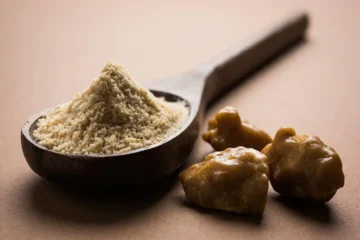Hing, or asafoetida, is a staple spice in Indian kitchens known for its intense aroma and digestive benefits. Available in multiple forms—powder, crystal, and paste—it plays a vital role in enhancing flavors across diverse cuisines. But which hing form is best for you? In this blog, we’ll break down each type in detail, helping you make the right culinary choice for your needs.
1. What are the differences in flavor and aroma between hing powder, crystal, and paste?
Short Answer: Hing crystals are the purest and most potent in flavor, paste is rich and bold, while powder is milder and more user-friendly for daily cooking.
Long Answer:
- Hing Crystals: These are the least processed and closest to the natural resin extracted from the plant. Their sharp, sulfurous aroma may be overwhelming at first, but they mellow beautifully when cooked in oil, lending a deep savory taste known as umami. They’re especially prized in traditional Indian households for their purity and strong medicinal properties.
- Hing Paste: Created by mixing hing powder or crystals with water or other binders, hing paste delivers a strong, quick-hit flavor that’s ideal when time is short. It retains a significant portion of the crystal’s aroma, offering a great balance between intensity and ease of use.
- Hing Powder: The most widely used variant, hing powder typically contains additives like rice flour or gum arabic to make it more manageable. While it’s less potent, it’s still flavorful when used correctly. Its aroma is less overpowering, making it suitable for those new to hing.
2. Which hing form is easiest to use in daily cooking, and how do they compare in convenience?
Short Answer: Hing powder is the easiest and most convenient form for daily use due to its mildness and pre-blended format.
Long Answer:
- Hing Powder: The go-to choice for most home cooks. It’s pre-diluted and easy to measure. A quick pinch can be added to hot oil or ghee during tadka (tempering), and it integrates effortlessly into dals, curries, and stir-fries. Ideal for busy kitchens.
- Hing Paste: Slightly less common but still practical. The paste form eliminates the need to crush or dilute. Just a tiny spoonful can be added directly to your cooking, which makes it a favorite in commercial or large-scale kitchens where quick preparation matters.
- Hing Crystals: Although highly valued for their purity and strength, crystals require pre-processing—typically crushing into a fine powder or dissolving in warm water. This additional step can be a hassle for everyday cooking but perfect for purists and traditionalists.
3. Does one form of hing have stronger potency than the others, and how should I adjust my usage?
Short Answer: Hing crystals are the most potent, followed by paste, then powder. Adjust usage based on form to avoid overpowering the dish.
Long Answer:
| Hing Form | Potency Level | Suggested Quantity for 1 Serving |
|---|---|---|
| Crystal | Very High | 1-2 small flakes |
| Paste | High | 1/8 tsp |
| Powder | Moderate | 1/4 tsp |
- Crystals, being the purest form, require the least quantity to deliver flavor. Use with caution to avoid an overwhelming taste.
- Hing paste offers a middle ground. If you’re used to hing powder and trying paste, start with half the quantity you would normally use.
- Powder is forgiving and can be adjusted based on taste. It’s best for those just starting to explore the spice.
4. How should I store different hing forms to maintain their freshness and effectiveness?
Short Answer: Store hing in airtight containers in a cool, dry place. Paste must be refrigerated after opening.
Long Answer:
- Hing Powder: Keep it in a dry, airtight container to prevent moisture absorption. Avoid storing near the stove or sink where humidity levels are high. With optimal storage, hing powder remains fresh and aromatic for up to a year.
- Hing Crystals: These are more stable but need protection from air and moisture. Store in an opaque glass or steel jar with a sealed lid. You may even double-wrap it due to its strong odor.
- Hing Paste: After opening, always refrigerate the container. Use a clean, dry spoon each time to maintain hygiene. It’s advisable to consume within 3–6 months to retain peak flavor and safety.
5. Are there specific dishes or cuisines that work best with powder, crystal, or paste hing?
Short Answer: Hing powder suits daily Indian cooking; crystals are ideal for traditional recipes; paste is versatile for stews, dals, and pickles.
Long Answer:
- Powder: Great for everyday recipes such as dal tadka, chana masala, khichdi, and sambar. Its easy blending and mild intensity make it ideal for dishes where hing plays a supporting role.
- Crystals: Ideal for dishes that need a strong hing presence, such as Rajasthani gatte ki sabzi, Maharashtrian amti, or traditional Ayurvedic recipes. Also works beautifully in pickles and chutneys that rely on intense, long-lasting aromas.
- Paste: Versatile and bold, hing paste shines in lentil-based stews, South Indian rasam, tamarind curries, and even in fusion dishes where umami is key. It’s also used in tempering for pickled vegetables and spicy chutneys.
Conclusion
Choosing the best hing form comes down to your cooking style and flavor preferences. If convenience is key, hing powder is the everyday hero. For purity and traditional flavor, go with crystals. If you prefer a bold, ready-to-use option, hing paste is your ally. Each form has its place in the culinary world, and having all three in your pantry allows flexibility for any dish or cuisine.
At Hingwala, we offer premium quality hing in powder, paste, and crystal forms—sourced ethically and processed with care to retain maximum aroma and health benefits. Whether you’re preparing a comforting bowl of dal or an elaborate festive meal, our range of hing products ensures you always have the perfect flavor enhancer at your fingertips.
Experiment with the different forms, and soon you’ll discover your favorite hing companion. Remember, when used right, hing doesn’t just elevate the taste of your food—it adds character and depth that lingers beautifully on the palate.





